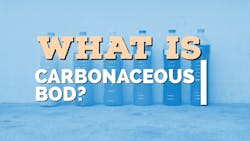What is carbonaceous biochemical oxygen demand (CBOD)?
Carbonaceous biochemical oxygen demand (CBOD) is one of the regulated parameters for polluted water, including for wastewater at wastewater treatment plants. Controlling the CBOD is important for wastewater treatment.
What is carbonaceous biochemical oxygen demand (CBOD)?
Carbonaceous biochemical oxygen demand (CBOD) measures dissolved oxygen depletion only from carbonaceous sources. When applied to wastewater, CBOD measures the potential of wastewater to deplete the oxygen level in the receiving water. There are two EPA methods for the measurement of CBOD:
- Standard methods for the examination of water and wastewater, method 5210B B-2001.
- In-situ Inc. Method 1004-8-2009 Carbonaceous Biochemical Oxygen Demand (CBOD) Measurement by Optical Probe.
The samples for the measurement of CBOD are incubated for five days prior to testing. The five days incubation period is the designated incubation time. Due to the five days incubation period, the measured values are often referred to as CBOD5.
The total BOD of wastewater is composed of CBOD and nitrogenous oxygen demand. The CBOD5 can be determined by using a nitrification suppressant in the BOD5 test.
What is the meaning of carbonaceous?
The Merriam Dictionary defines carbonaceous as “relating to, containing, or composed of carbon; rich in carbon.” Activated carbon, graphene, and carbon nanotubes are examples of carbonaceous materials.
From the wastewater perspective, CBOD measures dissolved oxygen depletion only from carbonaceous sources. In measuring CBOD, the contribution from nitrogenous bacteria is not considered.
Carbonaceous material such as activated carbon and graphene can be used as adsorbents for the removal of contaminants from wastewater. The carbonaceous materials, via advanced oxidation coupling processes, can treat organic wastes in wastewater treatment.
How does CBOD differ from biochemical oxygen demand?
Biochemical oxygen demand measures the rate at which microorganisms in the water use up dissolved oxygen when they metabolize organic pollutants. BOD also measures the chemical oxidation of inorganic matter, specifically the extraction of oxygen from water via chemical reactions. The greater the BOD, the more rapidly oxygen is depleted in the water, meaning less oxygen is available. The BOD in untreated sewage ranges from 200 mg/L to 600 mg/L. On the other hand, CBOD is more specific – it measures dissolved oxygen depletion only from carbonaceous sources.
Methods to reduce the CBOD in wastewater
The activated sludge process
The activated sludge process reduces the organic load in the wastewater after primary treatment. This process reduces the CBOD to the EPA established limits (based on 30 days average) to ≤ 25 mg/L.
How the activated sludge process works to reduce the CBOD
Two reactions occur in the activated sludge process – the chemoheterotrophic aerobic reaction and the chemoautotrophic aerobic reaction (also known as nitrification).
In the first reaction, i.e., chemoheterotrophic aerobic reaction, the microbes break down organic matter by utilizing oxygen and nutrients to produce carbon dioxide and water. In the process, CBOD is reduced.
In the second reaction, i.e., nitrification, ammonia and organic nitrogen are utilized by the microorganisms to produce oxidized nitrogen, usually nitrate. The second reaction reduces the nitrogenous BOD (called NBOD). Other reactions involving microorganisms also occur such as denitrification. Factors including the mean cell residence time (MCRT) which is the amount of time microbes are in the process, and the food to microorganism ratio (F:M) affect CBOD level outcome in this process.
Carbonaceous nitrification
The carbonaceous nitrification configuration consists of a nitrification reactor connected to a secondary clarifier. The influent goes to the nitrification clarifier and then to the secondary clarifier. Oxygen is added to the nitrification clarifier and the waste activated sludge is removed from the secondary clarifier. This activated sludge can be fed back into the influent.
The carbonaceous nitrification process reduces the CBOD and ammonia levels in the influent while increasing the nitrate level. This process does not remove nitrogen and requires a higher MCRT than the conventional sludge process.
Denitrification
In denitrification, denitrifying bacteria use oxygen to metabolize carbonaceous carbon and thus, reduce the CBOD. These bacteria use up the oxygen before they start to reduce the nitrate.
Combined nitrification and denitrification
The combined nitrification and denitrification process reduces the CBOD level without the addition of any air and also reduces the alkalinity demand. There are several set-ups known in the literature for carrying out combined nitrification and denitrification for reducing the CBOD.
The Wuhrmann process is a nitrification system attached to an anoxic tank for denitrification. The challenges for this system include the requirement for high alkalinity in the aeration tank to maintain a steady pH and the presence of nitrogen gas in the clarifier which inhibits settling.
The Ludzack-Ettinger process has the opposite tanks set-up compared to the Wuhrmann process – i.e., the anoxic tank is where the influent arrives and this tank is connected to an aeration tank. Nitrates from the returned activated sludge is introduced into the anoxic tank. This reduces the alkalinity demand of the process while also reducing the CBOD. To return more nitrate into the anoxic zone to increase the removal of nitrogen, the Ludzack-Ettinger process can be modified by adding the mixed liquor from the aeration tank into the anoxic tank.
The several processes for reducing the CBOD, as explained above, while they have simple setups, also require optimization and the selection of a process is dependent on the type and composition of the wastewater as well as regulatory requirements. Nevertheless, CBOD is among the parameters to monitor in wastewater treatment.
About the Author
Saleha Kuzniewski
Saleha Kuzniewski, Ph.D. has authored several publications in the fields of scientific research, biotechnology, and environmental regulations. She is the winner of the 2023 Apex award for publication excellence. She is also the founder of Environmental Remediation & Innovations, LLC. Kuzniewski can be reached at [email protected].


